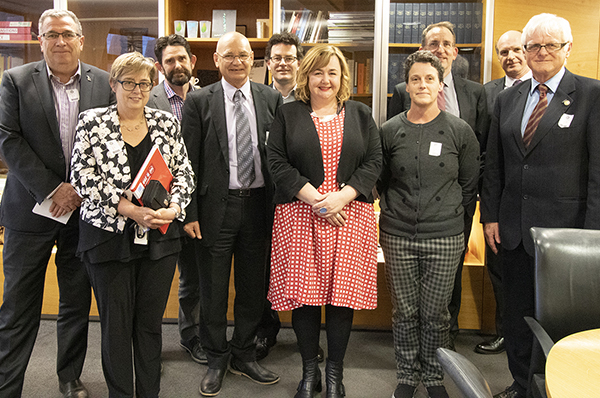Meeting with the Minister
IROs continue to grow as important part of science ecosystem
IRANZ executive members meeting with the Minister of Research, Science and Innovation the Hon. Megan Woods. From left: Peter Barrowclough, Lincoln Agritech; Wendy Turvey, WSP Opus; Richard Capie, BRANZ; John Bright, Aqualinc; Murray McCurdy, CRL Energy; the Hon. Megan Woods; Irene Braithwaite, MRINZ; John McDermott, Motu; Robert Matheson, Cawthron Institute; and Rob Whitney, IRANZ. Photo: Louise Thomas.
In late August, the Minister of Research, Science and Innovation the Hon. Megan Woods met with IRANZ members at the Beehive. The meeting was an opportunity for IRANZ Chair Dr John Bright to express IRANZ’s appreciation for the Government maintaining stability in the science funding system, and for the way the R&D Tax Incentive has been introduced to New Zealand’s science system.
Dr Woods said there would be no big surprises in the R&D Strategy, and that research excellence and impact would continue to be the big driver for future-funded projects. She said that Independent Research Organisations (IROs) were an important part of the science system, with a different voice to that of the universities and Crown Research Institutes. Typically, IROs were less encumbered by structure and represented a more agile approach to both team-formation and research delivery. The Minister also recognised the close connections IROs have to industry and the importance of these connections in underpinning research impact.
“This agility is good, but I’m also mindful that we need stability as well.”
Regional Research Institutes
Modelled on Nelson’s successful Cawthron Institute, the Regional Research Institutes (RRI) initiative has established four research institutes outside the main population centres of Auckland, Wellington and Christchurch that maximise the unique business, technology, and economic growth opportunities in their respective regions.
In 2015, up to $25 million over three years was committed to support the establishment of the Institutes, with a further $40 million committed in 2016. Dr Bright reported to the Minister that the four New Regional Research Institutes were now members of IRANZ, and all were up and running.
STEM workforce diversity
All members expressed concern to the Minister about the current lack of local capacity to fill science and technician shortages, with the clear message that more programmes are needed at school level to encourage a wider diversity of students into STEM careers. This is a real opportunity for improving workforce diversity as currently some educational scholarships are going unfilled and many career positions have to be filled by overseas recruitment.
HERA has an engineering scholarship which is targeting Maori students, and several IRANZ members have begun diversity initiatives in both primary and secondary schools, such as MRINZ, Cawthron, and Xerra, where they visit schools, or have classes come to them, with science programmes in their areas of expertise. A more coordinated approach at government level will alleviate the problem in the long term.
Members also talked about the steps they were taking in their businesses to improve diversity from the boardroom to the laboratory. They welcomed the Minister’s commitment to this and the recent steps taken by Government to better understand diversity in the science system. The conversation was a timely one, with IRANZ members having spent time earlier that day exploring lessons from the BRANZ-hosted National Science Challenge, which has been at the forefront of driving forward a Treaty Partnership approach to its work.
R&D Tax Credits
New Zealand lags behind the world on R&D spending, to lift this the Government is introducing an R&D tax incentive. This means that businesses will get back some of their money spent on R&D.
The R&D tax incentive will have a broad reach across our economy – from start-ups to established R&D performers – to encourage businesses of all sizes and scales to undertake R&D.
There will be a credit rate of 15 per cent, a $120 million cap on eligible expenditure, and a minimum R&D expenditure threshold of $50,000 per year. The minimum threshold does not apply if Approved Research Providers are used. Several IRANZ members are already Approved Research Providers.
The Minister said that the scheme has a broad R&D definition. It is understood that while Social and Economic research is excluded as a core R&D activity it could be included as a component of scientific and technological research programmes aimed, for example, to develop and commercialise new innovations.
Date posted: 16 September 2019

